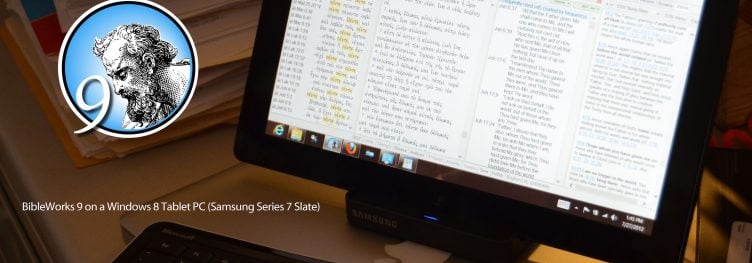As I said recently, the time has come to do a fresh Bible software review series. Last week I talked briefly about a resource using Logos, a topic to which I will return shortly. This week I want to focus on BibleWorks, which has kindly allowed me the opportunity to review BW9 (upgrading me from BW8), and I plan to proceed in four parts. I begin here with an introduction, sharing a bit of my history with BibleWorks and giving a glimpse of the program for those having little experience with it.
History
I have used BibleWorks for about ten years. I began to use it during my second year of New Testament Greek as an undergraduate, and it quickly became my primary tool for Greek and Hebrew exegesis. It remained so through my MA (which was in biblical languages). I learned back then how to use its print counterparts–critical texts with their apparatuses, concordances, lexicons, grammars–as any student should. Even so, the power of the software, not least its ability to perform complex searches quickly, was and is unsurpassed by any traditional tools. BibleWorks has consistently been among the elite software programs on the market, and it is the most affordable choice for those focused on original language exegesis. (More on the strengths of the various competitors later).
A Glimpse
BibleWorks accurately bills itself as an “original languages Bible software program for Biblical exegesis and research.” Its tools and texts focus on the Bible and related texts in ancient languages and modern translations. Many of its ancient texts are morphologically tagged which enables the user to perform advanced searches using a host of parameters (e.g., I can find every occurrence of the pluperfect and pluperfect periphrasis in Luke-Acts, which I did recently). Texts, tools, and resources are linked between windows enabling the user to see relevant data as the cursor is moved from word to word in a text. Such data includes lexical entries for given words, usage statistics in a book or version, text critical information, and a host of other information. BW9 comes standard with an impressive number of texts, reference resources, and tools, and a number of other important resources are available for purchase (e.g., HALOT, BDAG, BDF, etc.).
In the next few posts, I will dig into BW9’s features in greater detail and highlight what I think are the strengths of BibleWorks 9. And if you’re on Mac, don’t tune out!
For those who’ve purchased software in the past: What was your first program (Company, version, date) and why did you get it? Mine was BibleWorks 4 or 5 ~2003/4 for Greek exegesis. Before this purchase I used Accordance from Gramcord in the library. I know some of you can go a lot further back than this.

[…] the second installment of my BW9 review (see pt. 1), I want to focus on how BibleWorks performs on the Mac. Yes, natively on a […]
[…] I said in the intro (see also pt 2), I have been upgraded to BibleWorks 9 from BW8. In this post I want to highlight […]
[…] I reviewed the latest version of BibleWorks (v. 9). Today and in the coming weeks I will be posting reviews of Logos 5 and Accordance 10, […]